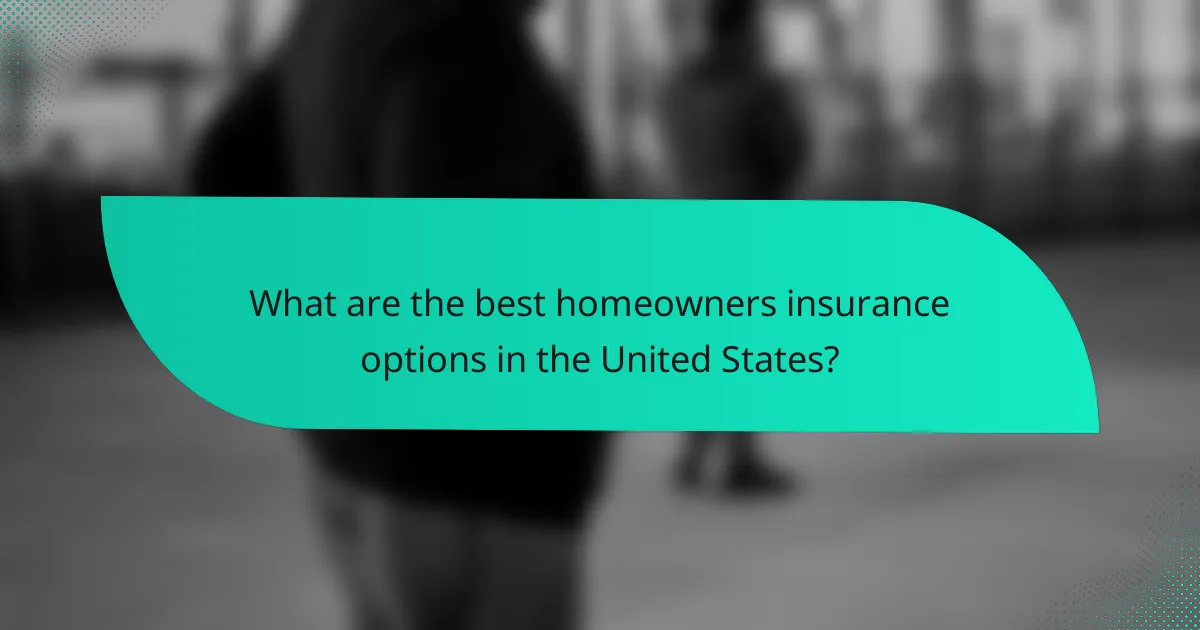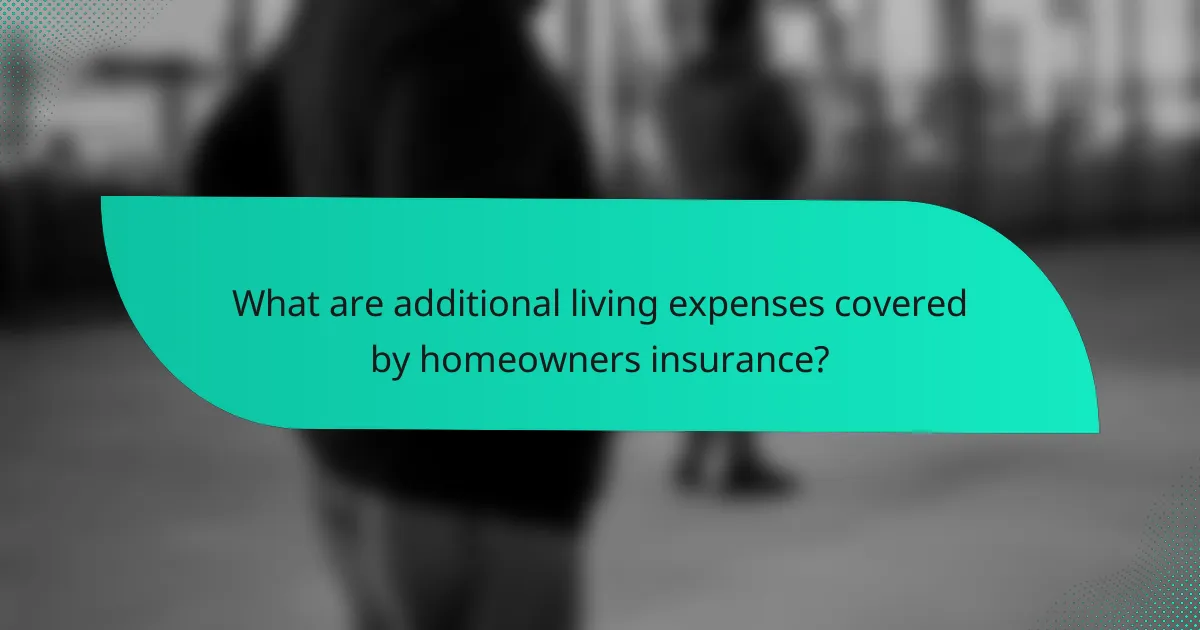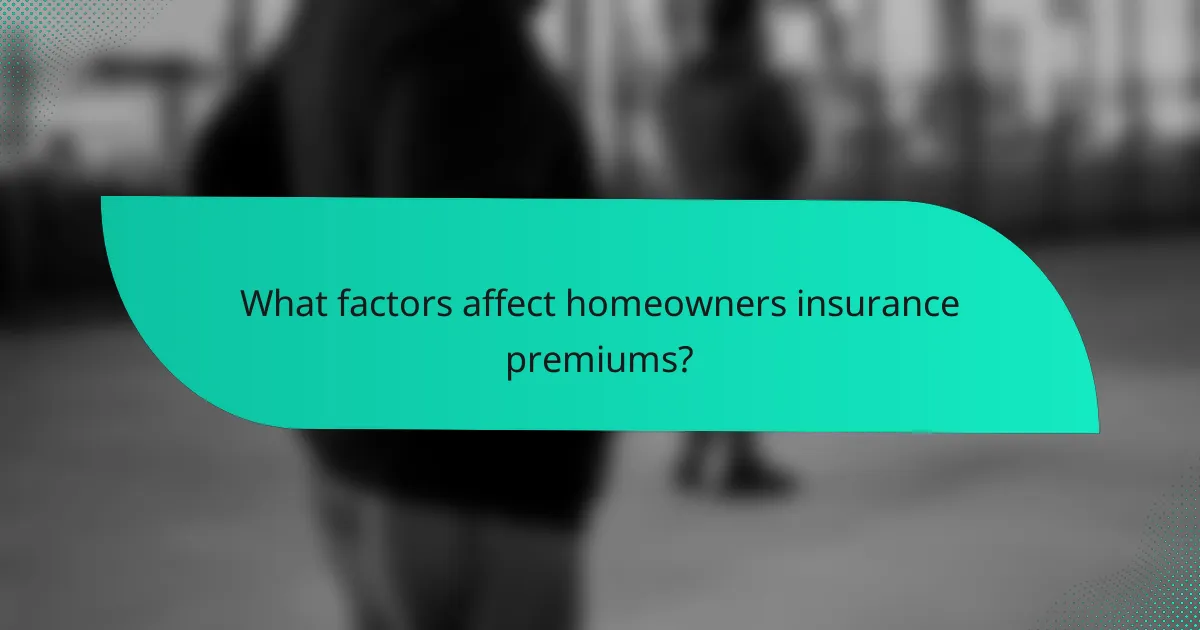Homeowners insurance is essential for safeguarding your property and personal belongings, offering comprehensive coverage against various risks associated with homeownership. It not only protects your home from damages but also provides liability coverage, ensuring you are financially secure in case of accidents or injuries on your property. Additionally, many policies assist with additional living expenses if you need to temporarily relocate due to covered damages, making it a crucial investment for homeowners.

What are the best homeowners insurance options in the United States?
The best homeowners insurance options in the United States typically provide comprehensive property protection, liability coverage, and assistance with additional living expenses. Factors such as coverage limits, deductibles, and customer service can vary significantly among providers, making it essential to compare policies based on individual needs.
State Farm homeowners insurance
State Farm offers a range of homeowners insurance policies that include property protection, personal liability coverage, and additional living expenses. Their customizable options allow homeowners to tailor coverage to their specific needs, such as adding endorsements for valuable items or home-based businesses.
State Farm is known for its strong customer service and extensive agent network, making it easier for policyholders to get assistance and claims support. Discounts are available for bundling policies or having a claims-free history, which can help reduce premiums.
Allstate homeowners insurance
Allstate provides homeowners insurance that covers property damage, liability, and additional living expenses, with options for customization. Their policies often include unique features like the Claim RateGuard, which prevents premium increases after a claim.
Allstate also offers various discounts, such as for new homes or safety features like smoke detectors. Their mobile app allows easy access to policy management and claims filing, enhancing the customer experience.
Progressive homeowners insurance
Progressive homeowners insurance focuses on providing affordable coverage with a straightforward online quote process. Their policies typically include property protection, liability coverage, and options for additional living expenses, which can be tailored based on the homeowner’s requirements.
One notable feature is the ability to compare quotes from multiple insurers through Progressive’s platform, helping customers find the best rates. Additionally, discounts for bundling with auto insurance can lead to significant savings.
USAA homeowners insurance
USAA offers homeowners insurance exclusively for military members and their families, providing comprehensive coverage that includes property protection, liability, and additional living expenses. Their policies are known for competitive rates and excellent customer service.
USAA also provides unique benefits such as coverage for military uniforms and personal property while stationed overseas. Members can access various discounts, including those for claims-free records and home security systems.
Farmers homeowners insurance
Farmers homeowners insurance includes a variety of coverage options, such as property protection, liability coverage, and additional living expenses. They allow homeowners to customize their policies with add-ons for specific needs, like identity theft protection or eco-friendly home upgrades.
Farmers is recognized for its extensive educational resources, helping customers understand their coverage options. They also offer discounts for bundling policies and for homes equipped with safety features, making it easier to save on premiums.

How does homeowners insurance protect property?
Homeowners insurance protects property by covering damages to the home and personal belongings, as well as providing liability coverage. This insurance typically includes several types of coverage that address various risks associated with homeownership.
Coverage for dwelling damage
Coverage for dwelling damage ensures that the structure of your home is protected against risks like fire, storms, and vandalism. Most policies cover the cost to repair or rebuild your home, up to the policy limit, which should reflect the current market value of your property.
When selecting coverage, consider factors such as local construction costs and potential natural disasters in your area. It’s advisable to review your policy regularly to ensure it meets your current needs, especially after major renovations.
Coverage for personal property
Coverage for personal property protects your belongings, such as furniture, electronics, and clothing, from risks like theft or damage. Typically, this coverage is a percentage of your dwelling coverage, often ranging from 50% to 70% of that amount.
To maximize your personal property coverage, create an inventory of your belongings and consider additional coverage for high-value items like jewelry or art. Be aware that some policies may have limits on specific categories of personal property.
Coverage for other structures
Coverage for other structures applies to buildings on your property that are not attached to your home, such as garages, sheds, or fences. This coverage usually provides a percentage of your dwelling coverage, often around 10% to 20%.
It’s important to review what is included under this coverage, as some policies may exclude certain structures or have specific limitations. Ensure that your policy adequately covers the replacement cost of these structures to avoid unexpected expenses after a loss.

What liability coverage is included in homeowners insurance?
Homeowners insurance typically includes liability coverage that protects you against claims of injury or damage to others on your property. This coverage can help pay for legal expenses and settlements if you are found responsible for an incident.
Personal liability protection
Personal liability protection is a key component of homeowners insurance that covers you if someone is injured on your property or if you accidentally cause damage to someone else’s property. This coverage usually extends to incidents that occur both on and off your premises, providing a safety net for various situations.
Most policies offer coverage limits ranging from $100,000 to $500,000, but higher limits may be available for an additional premium. It’s important to assess your needs based on your lifestyle and the potential risks associated with your property.
Medical payments coverage
Medical payments coverage is designed to cover medical expenses for guests who are injured on your property, regardless of fault. This coverage typically applies to minor injuries and can help pay for immediate medical costs, such as hospital visits or ambulance fees.
Coverage limits for medical payments often range from $1,000 to $5,000, which can help avoid larger liability claims. It’s advisable to review your policy to ensure that the limits are sufficient for your needs.
Legal defense costs
Legal defense costs are included in homeowners insurance liability coverage, meaning your insurer will pay for legal fees if you are sued for an incident covered by your policy. This can include attorney fees, court costs, and other related expenses, which can add up quickly without coverage.
It’s crucial to understand that legal defense costs are typically covered in addition to your liability limits, providing an extra layer of financial protection. Always verify the specifics of your policy to ensure you have adequate coverage for potential legal challenges.

What are additional living expenses covered by homeowners insurance?
Additional living expenses (ALE) covered by homeowners insurance refer to the costs incurred when a home becomes uninhabitable due to a covered peril. This coverage helps homeowners pay for temporary housing, food, and other necessary expenses while their home is being repaired or rebuilt.
Temporary housing costs
Temporary housing costs include expenses for lodging when your home is unlivable. This can range from hotel stays to rental apartments, depending on the duration of repairs. Homeowners should keep receipts and document the duration of their stay to ensure proper reimbursement from their insurance provider.
Typically, ALE coverage will pay for the difference between your normal living expenses and what you incur while living elsewhere. For instance, if your monthly mortgage is $1,500 and you pay $2,000 for a rental, the insurance may cover the additional $500.
Food and storage expenses
Food expenses may increase when you are living away from home, as you might need to eat out more often. Homeowners insurance can cover these additional food costs, but it’s essential to keep track of your spending. Some policies may have limits on how much they will reimburse for food, so check your coverage details.
Storage expenses can arise if you need to move your belongings out of your home during repairs. Insurance may cover the costs of renting a storage unit. Be sure to document all related expenses and confirm with your insurer what is included in your ALE coverage to avoid surprises.

What factors affect homeowners insurance premiums?
Homeowners insurance premiums are influenced by several key factors, including the location of the property, its value, and the homeowner’s claims history. Understanding these elements can help you anticipate costs and make informed decisions about your coverage.
Location and property value
The location of your home significantly impacts your homeowners insurance premiums. Areas prone to natural disasters, such as floods or earthquakes, typically have higher rates due to the increased risk of damage. Additionally, urban settings may have higher premiums compared to rural areas because of the higher likelihood of theft or vandalism.
Property value is another crucial factor. Generally, the more valuable your home, the higher your insurance costs will be, as it would take more to repair or replace it in the event of a loss. For example, a home valued at $300,000 may have a premium that is significantly higher than one valued at $150,000, reflecting the difference in potential payout.
When evaluating your homeowners insurance, consider both location and property value carefully. You may want to consult with an insurance agent to assess how these factors specifically affect your premiums and explore options for reducing costs, such as increasing your deductible or bundling policies.
